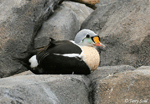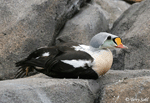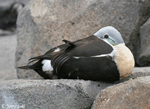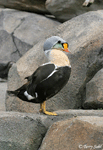| Length: 22 inches | Wingspan: 36 inches | Seasonality: Non-resident in South Dakota |
| ID Keys: Adult breeding males unmistakable. Non-breeding males dark brown overall with orange bill. Females tan with dark "chevron" markings on flanks | ||
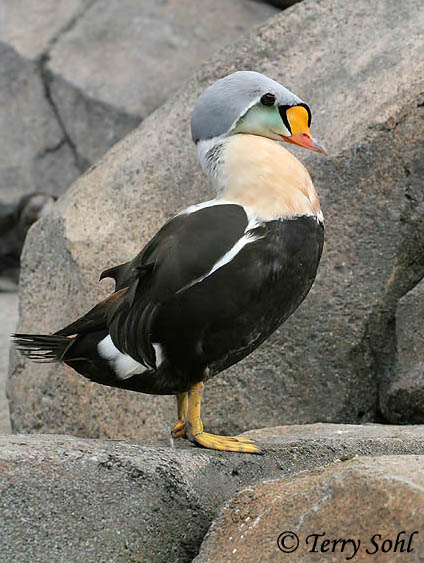 The
King Eider is a uniquely patterned sea-duck of the far northern extremes of
North America. They are strongly tied to salt-water habitats in most
seasons, although they can be found on inland freshwater lakes of the far
north during the summer breeding season. They are gregarious and often found
in very large flocks, with flocks in migration sometimes exceeding 10,000
individual birds.
The
King Eider is a uniquely patterned sea-duck of the far northern extremes of
North America. They are strongly tied to salt-water habitats in most
seasons, although they can be found on inland freshwater lakes of the far
north during the summer breeding season. They are gregarious and often found
in very large flocks, with flocks in migration sometimes exceeding 10,000
individual birds.
Habitat: During the summer breeding season, they are found on high Arctic tundra in extreme northern Alaska and Canada. In winter, they are found a bit further south along the coasts or around the edge of pack ice.
Diet: Feeds mostly on mollusks, but depending on season and location, they will also feed on crustaceans, aquatic insects and larvae, and occasionally plant material.
Behavior: King Eiders are excellent divers, and obtain most of their food by diving underwater, sometimes to depths of up to 100 feet or more.
Nesting: The nest is on a raised patch of ground near water, and is usually just a depression lined with down and vegetation. The female alone incubates the eggs. The young feed themselves upon hatching and leaving the nest, but the female will tend to them and protect them.
Song: During courtship, the male gives a low pitched moaning call that rises in pitch toward the end.
Migration: Summers throughout much of the high Arctic, where it is often found in relatively large numbers. In winter, moves southward along both costs of North America. Migration is typically along the coasts, as the species is only very rarely found inland.
Interactive eBird map: Click here to access an interactive eBird map of King Eider sightings
Similar Species: Males are distinctive in breeding plumage. Non-breeding males could possibly be confused with other eiders, but even the relatively drab non-breeding males are distinctive from other non-breeding eider males. Females may possibly be confused with a relatively large number of duck species.
Conservation Status: There are currently no perceived major threats to King Eider populations, and the IUCN cites it as a species of "Least Concern".
Further Information: 1) Cornell's All About Birds - King Eider
2) Ducks Unlimited - King Eider
3) Alaska Sea Life Center - King Eider
Photo Information: June 25th, 2006 - Alaska Sea Life Center in Seward, Alaska - Terry Sohl
| Click below for a higher-resolution map |
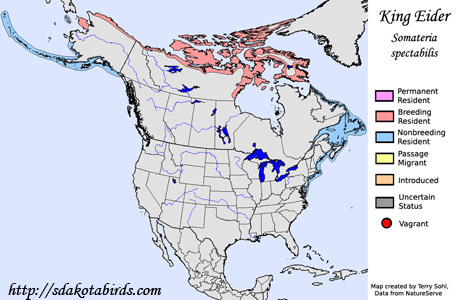 |
| South Dakota Status: Non-resident in South Dakota |
Additional King Eider Photos
Click for a higher-resolution version of these photos
